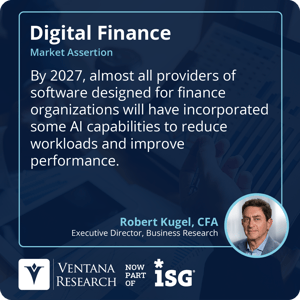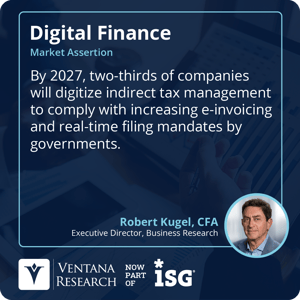Zoho recently held its annual analyst day to communicate its strategy, objectives and product roadmap. The privately held company, headquartered in Chennai, Tamil Nadu, India, has an unconventional approach to the software market. Its self-described corporate philosophy emphasizes making bold moves that challenge assumptions. Its design engineering approach stresses simplicity and cost while aiming to provide easy-to-use software with sufficient capabilities to improve personal and organizational performance.
Zoho’s suite offers more than 50 applications. Each addresses a specific business problem. The applications can be customized relatively easily and linked together as needed. ISG-Ventana Research covers Zoho from multiple perspectives. We all assess its overall strategy and direction, but my colleague Keith Dawson provides his perspective on the customer experience, while David Menninger looks at its data and analytics capabilities.
The ability to embed predictive and generative artificial intelligence is becoming an important differentiator in business software because these are catalysts for boosting productivity. Enterprises are showing a willingness to pay more for AI, but only to a point, making it strategically important to have the infrastructure to deliver a rich set of AI functionality at low cost. Zoho’s long-term strategy is designed to benefit from a future IT landscape that rewards a very low total cost of ownership business model with a steady accretion of wallet share. This distinguishes it from most software providers and the standard technology industry emphasis on rapid domination of a market category.
To better understand Zoho’s strategy, it’s useful to look at it in a broader context. The arc of business computing has traced a steady evolution to ever more loosely coupled systems. In computing architecture, a loosely coupled system is designed so that a change in one component has a limited impact on the capabilities or performance of another, and each component in the system makes little or no use of the constructs of any other component. Tight coupling is just the opposite. Until the 1990s, applications were an integral part of a hardware bundle, in part because this offered a more efficient use of expensive compute and storage resources. Then, Moore’s law and clever computer science (including more productive programming languages and relational databases) fostered an explosion in business applications such that today, almost every aspect of an enterprise’s activity is managed by software. However, the first generation of these systems were monolithic, meaning there were cost and performance advantages to doing everything in a single package.
Over the past 15 years, steady advances in computer science (including techniques such as containerization, service-oriented architecture and application programming interfaces) have made it much easier and sometimes less expensive and more advantageous to use focused applications to augment the functionality of a core system such as customer relationship management or ERP. Along with this, low-code and no-code programming enables people with a deep understanding of business needs but a limited technical background to quickly translate requirements into software that automates and controls a process or set of tasks within a process. This has created a market for software that:
- Augments functionality in a core system, adding data collection or task execution that complements the core.
- Offers similar functionality as the core but is easier and less expensive to implement and maintain.
- Has operating characteristics that make it easier to use.
Often, this application replaces purely manual and paper-based systems that use spreadsheets in email or collaboration systems. Typically, these focused systems are priced below the threshold where a formal business case and levels of review are necessary to authorize their purchase. The introduction of AI is likely to multiply opportunities for this type of software.
In 2023, Zoho reported it had 100 million users and $1 billion in revenues. It has over 600 partners in its marketplace. Zoho’s emphasis on low-code and no-code should be attractive for partners because it boosts productivity and facilitates the ability to translate the domain and vertical expertise into software that is well suited to the needs of a business. And Zoho has invested heavily in its infrastructure–including networks, data centers, hardware and storage–to support its low-cost business model while providing customers with the option of having a private cloud to deal with privacy and concerns about the use of data.
As is the case with every business application provider, Zoho is adopting AI and generative AI wherever practical. ISG-Ventana Research asserts that by 2027, almost all providers of software designed for finance organizations will incorporate AI capabilities to reduce workloads and improve performance.
software designed for finance organizations will incorporate AI capabilities to reduce workloads and improve performance.
At the same time, how AI is infused into business applications and the technology supporting it (especially in managing data) is important. In this case, Zoho pointed to “contextual intelligence” (the application of AI in a specific business context) as a broad theme in its product roadmap. The point here is to ensure that the technology understands the context of the interaction with the user, which requires a finer sense of the business relationship, data and actions while respecting the permissions necessary to have access to information and answers.
The roadmap presentations also highlighted the need for business application providers to orchestrate multiple language models for task execution, since processes will use some combination of narrow, small, medium and large language models. Moreover, these models are likely to be trained for specific expertise domains (such as legal, accounting or engineering) or vertical industries as well as an enterprise’s specific content to ensure that the result is as faithful as possible to intent and consistent with its characteristics.
Contextual intelligence can substantially increase productivity. For example, business analysts spend significant time assembling data in a tabular report and creating commentary about the numbers. Used with natural language processing, contextual intelligence can create a first draft of business commentary that describes the analysis, highlights the causal factors driving results and provides recommendations or action items. As a simple illustration, the system could autogenerate a formatted chart along with commentary like, “Sales were up 17% in North America as revenue from the X division was boosted by the introduction of product A, which accounted for 23% of its sales. Operating margin in the region was 14.3% as reported and 13.2% in constant currency compared to...”
Freeing up time spent on less valuable work enables business and financial analysts to do more of what they are hired to do: analyze and find actionable insights. The technology also expands the scope of self-service reporting, where all executives and managers can simply ask questions and get answers.
Customers who spoke at the analyst event provided a wide range of use cases for Zoho’s offerings in multiple parts of a business. Their comments confirmed its value in supporting organizations that needed to replace either outmoded technology or manual operations for specific uses that are simple for those using the software to understand and measure with limited risk.
For the finance and accounting department, Zoho stresses its ability to deliver operational efficiency and accounting accuracy while addressing sometimes complex local requirements and reducing compliance risks. The company’s target market is small and midsize enterprises, which often have the same basic requirements as larger organizations but with limited resources. The product suite has a core accounting system as well as payroll, inventory and order management, invoicing and billing, travel and expense, indirect tax (such as value-added and sales and use) and e-commerce. ISG-Ventana Research asserts that by 2027, two-thirds of enterprises will digitize indirect tax management to comply with increasing e-invoicing and real-time tiling mandates.
and reducing compliance risks. The company’s target market is small and midsize enterprises, which often have the same basic requirements as larger organizations but with limited resources. The product suite has a core accounting system as well as payroll, inventory and order management, invoicing and billing, travel and expense, indirect tax (such as value-added and sales and use) and e-commerce. ISG-Ventana Research asserts that by 2027, two-thirds of enterprises will digitize indirect tax management to comply with increasing e-invoicing and real-time tiling mandates.
Implementation partners serving customers have relatively easy-to-use tools for customization and configuration. The company offers APIs to facilitate integration with other applications and data stores and low-code or no-code software development kits partners can use to incorporate subject matter expertise in some vertical industry or service domain. It is increasing its use of AI for accurate ingestion of document data, managing bank feeds and auto-matching these to transactions as well as detecting fraud and anomalies. How enterprises pay for goods and services is also changing as alternative payment systems have attempted to disrupt this part of commerce by using technology to reduce cost and friction.
Zoho also aims to make e-commerce more approachable for SMEs around the world, lowering technology barriers so these companies can operate commission-free in a low-cost environment. It supports the Open Network for Digital Commerce in India, designed to replicate the capabilities of e-commerce giants for use by smaller retailers. Rather than being vertically integrated, ONDC is a loosely coupled network that enables individual buyers, sellers and logistics providers to interact and fulfill a transaction using any software.
Zoho’s direction and strategy face several challenges. Zoho is still not as well known in North America and Europe as its larger software competitors, making it necessary to continue marketing efforts to build brand awareness and highlight differentiation. The company also faces a market reality that buying complementary capabilities from a separate software provider can face internal resistance from those opposed to proliferating vendors. Plus, a go-to-market approach built around a land-and-expand direction almost always faces the difficulty of adding revenue from selling additional functionality, especially if the economic buyer is in a different business unit or department. For that reason, Zoho has placed greater emphasis on its Zoho One suite. Even here, there is a challenge in getting adoption and use of more of its capabilities to create referenceable customers in multiple departments. And although the company has added new service provider logos over the past two years, it remains to be seen the degree to which these organizations will dedicate efforts, given the smaller size of Zoho engagements.
I recommend that small and midsize organizations consider Zoho, especially when software from a single provider is preferred to help run multiple departments. Information technology-focused consulting organizations, especially those with vertical specialization, should investigate the value of Zoho in using low-code or no-code to embed industry expertise to improve clients’ productivity and performance. Larger midsize- and larger enterprises may find that Zoho’s applications can fill gaps or provide capabilities at a lower cost of ownership compared to other software providers.
Regards,
Robert Kugel
 software designed for finance organizations will incorporate AI capabilities to reduce workloads and improve performance.
software designed for finance organizations will incorporate AI capabilities to reduce workloads and improve performance.  and reducing compliance risks. The company’s target market is small and midsize enterprises, which often have the same basic requirements as larger organizations but with limited resources. The product suite has a core accounting system as well as payroll, inventory and order management, invoicing and billing, travel and expense, indirect tax (such as value-added and sales and use) and e-commerce. ISG-Ventana Research asserts that by 2027, two-thirds of enterprises will digitize indirect tax management to comply with increasing e-invoicing and real-time tiling mandates.
and reducing compliance risks. The company’s target market is small and midsize enterprises, which often have the same basic requirements as larger organizations but with limited resources. The product suite has a core accounting system as well as payroll, inventory and order management, invoicing and billing, travel and expense, indirect tax (such as value-added and sales and use) and e-commerce. ISG-Ventana Research asserts that by 2027, two-thirds of enterprises will digitize indirect tax management to comply with increasing e-invoicing and real-time tiling mandates. 








